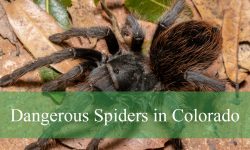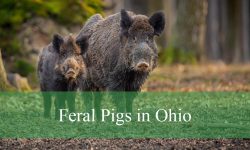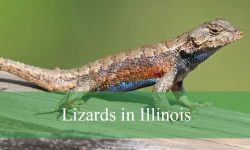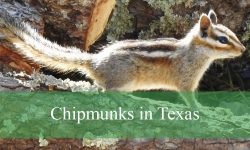In Ohio, wasps vary greatly in size and behavior, from solitary hunters to colony-forming species such as hornets and yellowjackets. These insects play important roles in controlling pests and pollinating plants across the state.
While some wasps can be aggressive around their nests, many are harmless to humans and contribute significantly to Ohio’s ecosystem. Their diverse sizes, colors, and behaviors make them both intriguing and beneficial.
From mud daubers and paper wasps to cicada killers and spider wasps, Ohio’s 33 most common species each have unique nesting habits and hunting strategies, making them fascinating to observe for naturalists and gardeners alike.
Different Types of Wasps Found in Ohio
Paper Wasp (Polistes spp.)
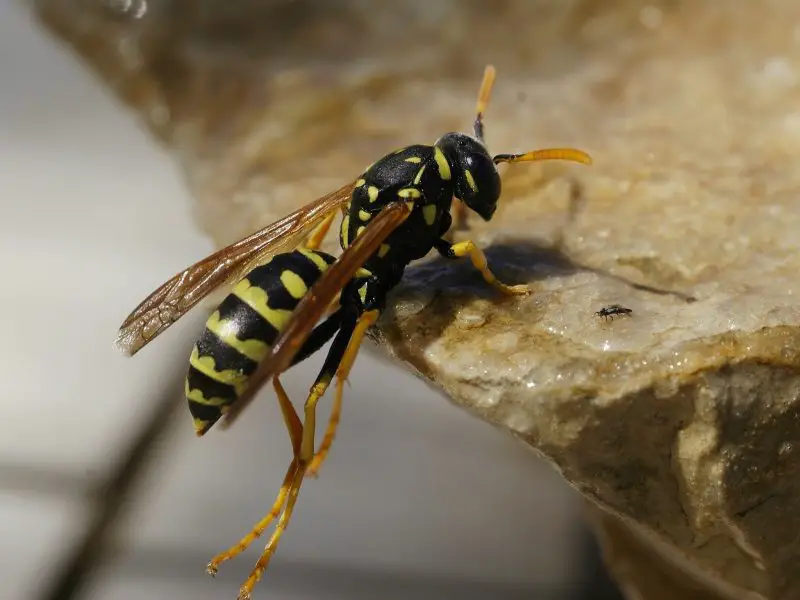
Paper wasps are one of the most recognizable wasps in Ohio, thanks to their umbrella-shaped nests built from chewed wood fibers. They have slender bodies with narrow waists, long dangling legs in flight, and brown, black, or reddish coloration with yellow markings. These wasps typically measure around 0.7 to 1 inch in length.
They are semi-social wasps, living in small colonies of less than 100 individuals. Paper wasps help control caterpillars and other soft-bodied insects, which makes them beneficial for gardens. They also feed on nectar, acting as incidental pollinators.
Nests are often attached to eaves, porch ceilings, and sheltered areas around human homes. Despite their proximity to people, paper wasps are not overly aggressive unless their nest is disturbed.
In Ohio, paper wasps are commonly seen from late spring through early fall, with colonies dying off as winter arrives. Only fertilized queens survive to start new nests the following year.
Eastern Yellowjacket (Vespula maculifrons)
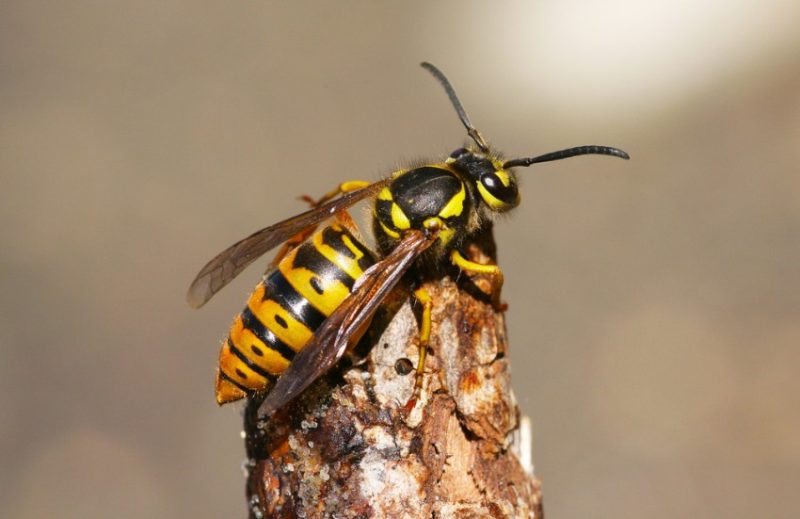
The Eastern Yellowjacket is a common wasp across Ohio, easily recognized by its black and bright yellow patterned body. These wasps are smaller than paper wasps, usually about 0.5 inches long, and have stockier bodies with shorter legs that do not dangle in flight.
They are social insects that live in large colonies, sometimes containing thousands of individuals. Their nests are usually built underground in abandoned rodent burrows, though occasionally they nest in walls or structures.
Eastern Yellowjackets are highly aggressive when defending their colonies. They are known to sting repeatedly, making them a nuisance at outdoor gatherings where they scavenge for food and sugary drinks.
Despite their bad reputation, they play an important ecological role by preying on flies, caterpillars, and other insects, helping regulate pest populations in Ohio’s ecosystems.
German Yellowjacket (Vespula germanica)
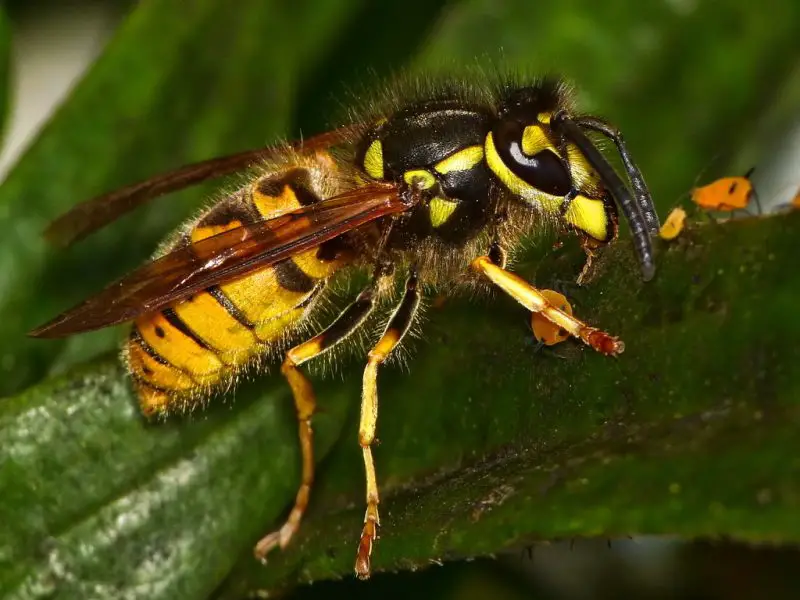
The German Yellowjacket is another species found in Ohio, similar in appearance to the Eastern Yellowjacket but with distinctive black dots on its face. Adults measure about 0.5 inches long and have the classic black-and-yellow banded body.
Unlike the Eastern Yellowjacket, German Yellowjackets prefer nesting in man-made structures such as attics, wall voids, and sheds. Their colonies can grow very large, sometimes exceeding several thousand wasps.
They are particularly aggressive around human food sources, often invading picnics and trash bins. Because of their defensive behavior and large colonies, they are considered a public health pest in Ohio cities and suburbs.
Despite their nuisance factor, they serve as predators of crop-damaging insects, contributing to natural pest control in agricultural areas.
Common Aerial Yellowjacket (Dolichovespula arenaria)

The Common Aerial Yellowjacket differs from other yellowjackets by building exposed paper nests above ground, often hanging from trees, shrubs, or buildings. Their nests can become large, sometimes reaching the size of a basketball.
Adults are about 0.5 inches long, with black bodies marked by bright yellow patterns. They are strong fliers and defend their nests aggressively if disturbed. Like other yellowjackets, they can sting repeatedly, making them a threat in residential areas.
These wasps are opportunistic feeders, scavenging on carrion, fruit, and human food. However, they also hunt insects, playing a role in natural pest control.
In Ohio, aerial yellowjackets are most active during summer and early fall, with colonies dying off in winter. Only fertilized queens survive to start new colonies the following spring.
Bald-Faced Hornet (Dolichovespula maculata)
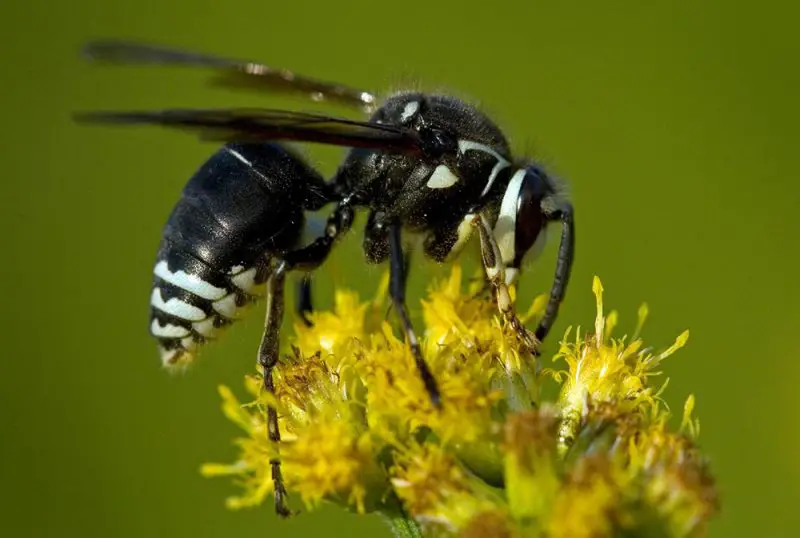
The Bald-Faced Hornet is a striking black-and-white wasp that can grow up to 0.75 inches long. Despite its name, it is technically a type of yellowjacket. Its white markings on the face and thorax make it easy to identify.
These hornets build large, enclosed paper nests shaped like footballs, often suspended in trees or shrubs. Nests can house several hundred individuals at peak population during late summer.
Bald-Faced Hornets are highly defensive of their nests and can deliver painful stings. They are among the more aggressive wasps in Ohio, attacking in swarms if threatened.
They feed on nectar but are also voracious predators of flies, caterpillars, and other insects, making them ecologically valuable despite their fearsome reputation.
European Hornet (Vespa crabro)
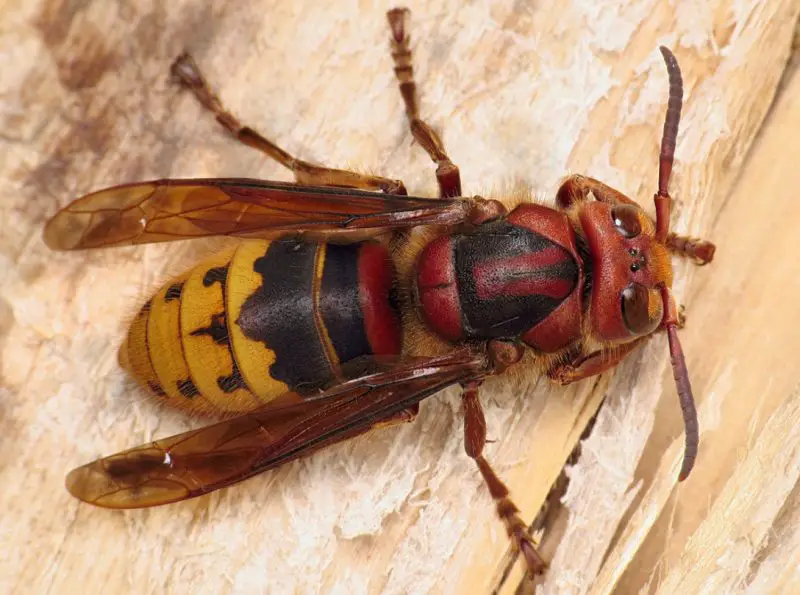
The European Hornet is the largest social wasp in Ohio, with adults reaching up to 1.5 inches long. It has a reddish-brown head and thorax, with a yellow-and-black striped abdomen, making it bulkier than yellowjackets and paper wasps.
Unlike bald-faced hornets, European hornets are active both day and night. They nest in hollow trees, attics, barns, and wall voids, often creating large paper nests hidden from view. Colonies can grow to several hundred individuals during summer.
Though they can sting multiple times, European hornets are less aggressive than yellowjackets unless their nest is directly threatened. They are strong fliers and sometimes drawn to outdoor lights at night.
In Ohio, they are beneficial predators, hunting grasshoppers, bees, and other insects. However, their habit of girdling tree bark to feed on sap can damage ornamental trees and shrubs.
Cicada Killer Wasp (Sphecius speciosus)
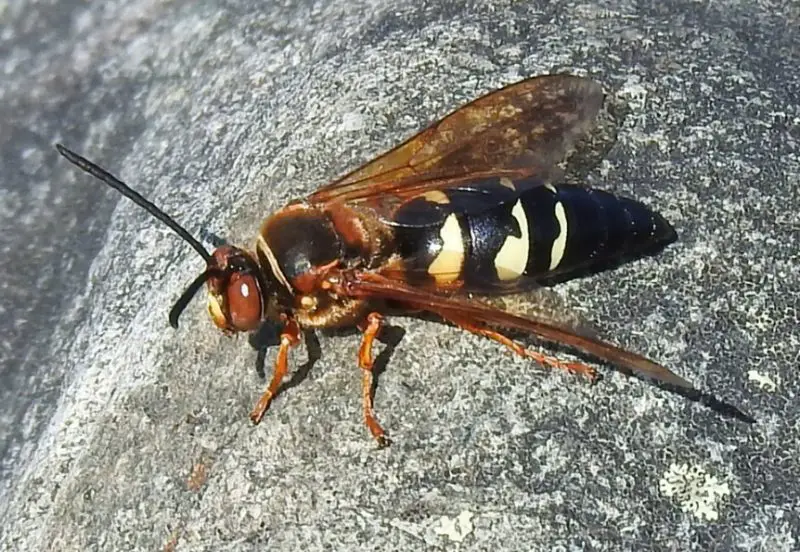
The Cicada Killer Wasp is one of the most impressive solitary wasps in Ohio, with females reaching up to 2 inches long. They have black bodies with yellow markings and reddish wings, making them easy to spot in summer.
These wasps dig burrows in sandy or loose soil, where females drag paralyzed cicadas to feed their larvae. Despite their intimidating size, cicada killers are not aggressive toward humans and rarely sting unless handled.
Their burrows can appear in lawns, gardens, or sandy banks, sometimes causing alarm when large numbers gather in the same area. However, they do not form colonies like hornets or yellowjackets.
In Ohio, cicada killers are most active in July and August when cicadas are abundant. They play an important ecological role in controlling cicada populations.
Great Black Wasp (Sphex pensylvanicus)
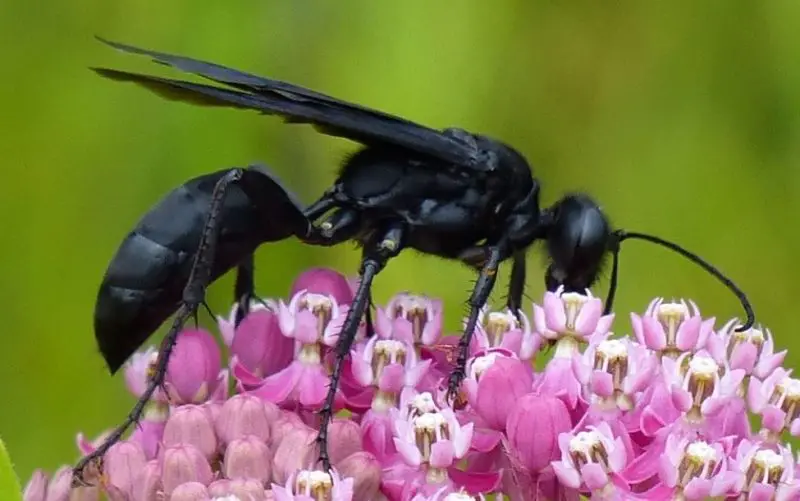
The Great Black Wasp is a solitary wasp known for its all-black, shiny body and long, narrow wings. Adults can grow over 1.5 inches long, making them among the largest solitary wasps in Ohio.
These wasps are non-aggressive and rarely sting people. Females dig burrows in soil, where they hunt katydids and crickets to feed their developing young. Each burrow may contain several paralyzed insects sealed with an egg.
Adults are often seen visiting flowers, especially milkweed, mountain mint, and goldenrod, where they act as effective pollinators. Their large size and strong flight make them easy to spot in open fields and gardens.
In Ohio, they are commonly observed from mid-summer to early fall, especially in sunny habitats with sandy or loose soil for nesting.
Blue-Winged Wasp (Scolia dubia)
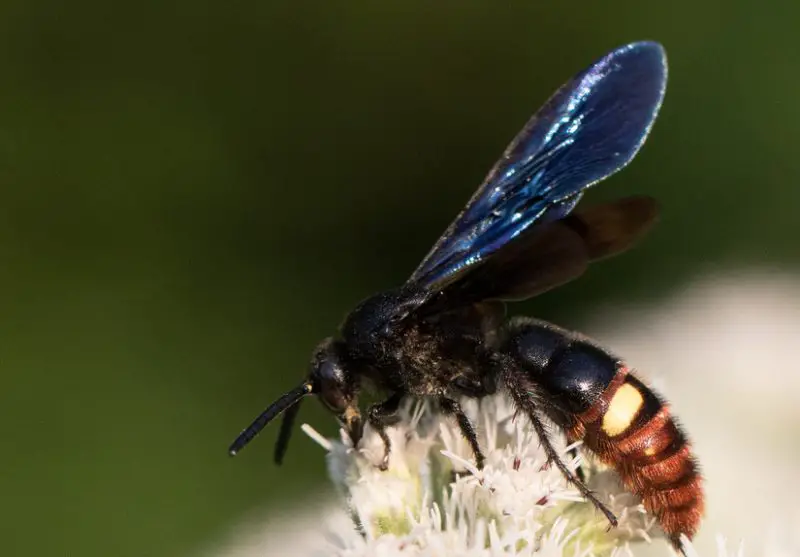
The Blue-Winged Wasp is a striking insect with metallic blue-black wings and a black body marked with two orange-yellow spots on its abdomen. Adults measure about 0.8 to 1 inch long and are often found near flowering plants.
These wasps are solitary and beneficial, as females seek out beetle grubs, especially Japanese beetle larvae, which they paralyze and use as food for their young. This makes them a natural ally for gardeners and farmers in Ohio.
Blue-Winged Wasps are not aggressive toward people. Instead, they spend much of their time visiting flowers such as goldenrod, milkweed, and clover, where they act as pollinators.
They are most active during late summer when beetle populations peak, helping keep destructive pests under control across Ohio landscapes.
Four-Toothed Mason Wasp (Monobia quadridens)
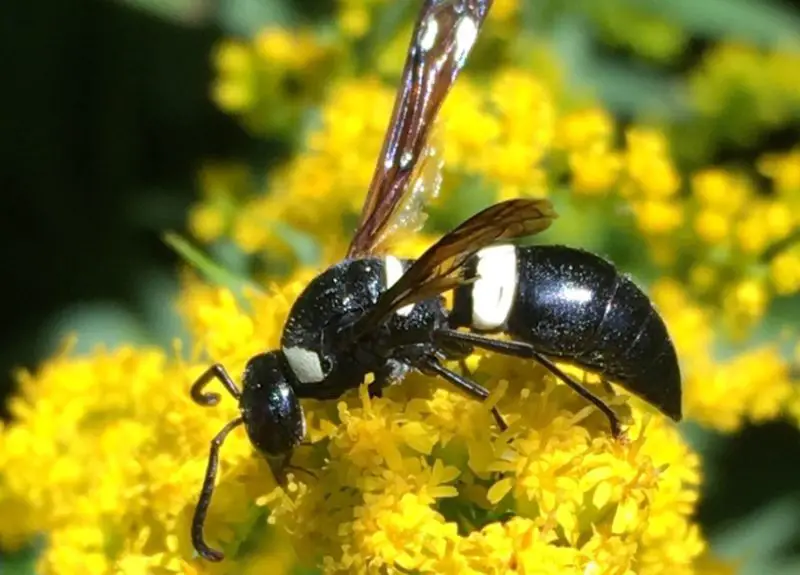
The Four-Toothed Mason Wasp is a medium-sized solitary wasp, about 0.6 to 0.9 inches long, with a mostly black body and a single white band across its abdomen. It gets its name from the four teeth on its mandibles.
These wasps use pre-existing cavities, such as hollow stems, beetle burrows, or man-made holes, to create their nests. They divide the space into chambers using mud walls, placing paralyzed caterpillars inside for their larvae.
Adults are often seen visiting flowers, feeding on nectar, and contributing to pollination. They are calm wasps that rarely sting, making them harmless to humans despite their predatory habits.
In Ohio, Four-Toothed Mason Wasps are active during summer months, especially in gardens, meadows, and wooded edges where caterpillars and suitable nesting sites are abundant.
Potter Wasp (Eumenes spp.)
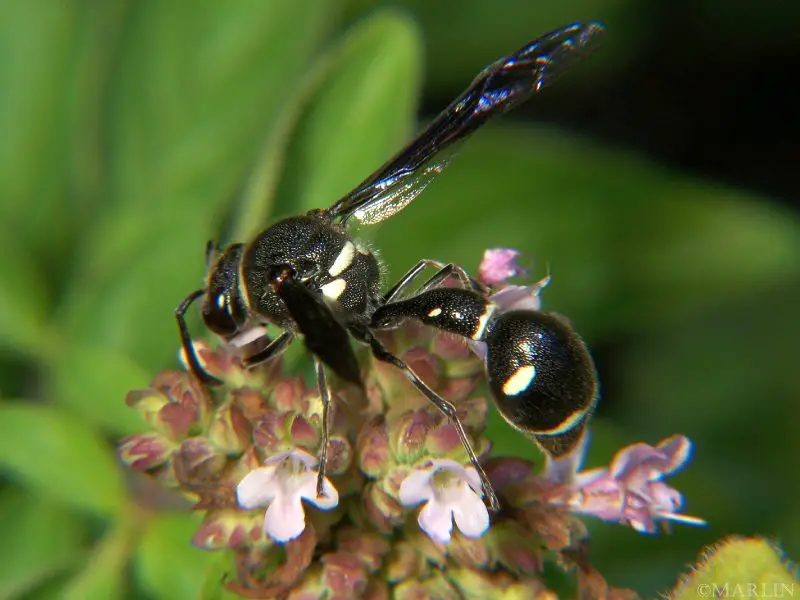
Potter wasps are small to medium-sized solitary wasps, usually measuring between 0.5 and 0.8 inches long. They are black or dark brown with contrasting white or yellow markings and are known for their unique nesting behavior.
Unlike paper wasps that build large communal nests, potter wasps construct small, jug-shaped clay pots attached to twigs, walls, or rocks. Each pot holds a single egg and a supply of paralyzed caterpillars for the larva to feed on.
Potter wasps are non-aggressive and rarely sting, making them harmless to humans. They spend much of their time foraging for caterpillars and nectar.
In Ohio, these wasps are active from late spring to early fall, often found in gardens, meadows, and woodland edges where caterpillars are plentiful.
Organ-Pipe Mud Dauber (Trypoxylon politum)
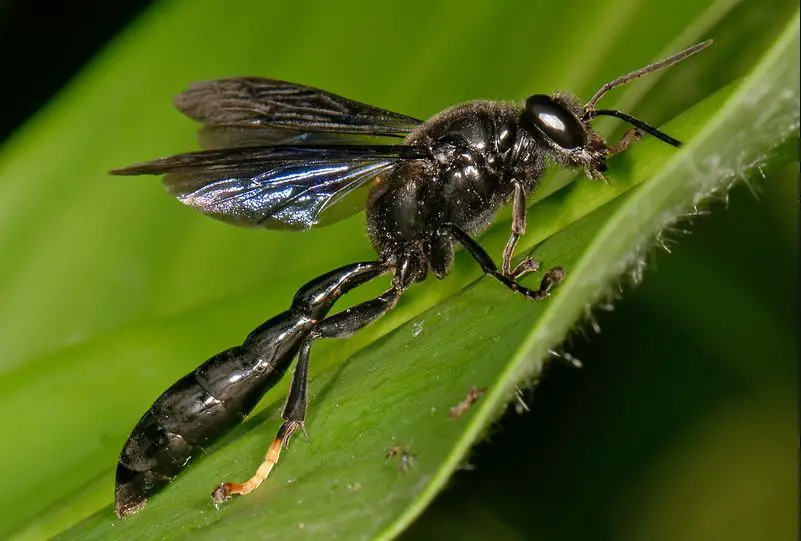
The Organ-Pipe Mud Dauber is a sleek, black wasp that measures about 1 inch long. Its name comes from its distinctive nest, which resembles a series of parallel mud tubes that look like organ pipes.
These solitary wasps are excellent hunters of spiders. Females collect and paralyze spiders, sealing them inside their mud tubes along with an egg to nourish their offspring.
Unlike aggressive social wasps, organ-pipe mud daubers are calm and rarely sting. They are frequently seen carrying mud or spiders back to their nests, which are often built on buildings, cliffs, or tree trunks.
In Ohio, they are most noticeable during summer, especially near structures where they can attach their unique pipe-shaped nests.
Black-and-Yellow Mud Dauber (Sceliphron caementarium)

This mud dauber is easily recognized by its long, thread-like waist and black-and-yellow patterned body. Adults range from 0.8 to 1 inch long and have slender bodies with long legs.
Black-and-yellow mud daubers build mud nests that look like small lumps of mud plastered under eaves, inside barns, or in sheds. Each nest cell contains a spider provisioned for the developing larva.
They are solitary and non-aggressive, rarely stinging unless handled. Instead, they are beneficial predators that help reduce spider populations in and around homes.
In Ohio, these wasps are active throughout summer, and their mud nests are commonly noticed in human structures.
Blue Mud Dauber (Chalybion californicum)
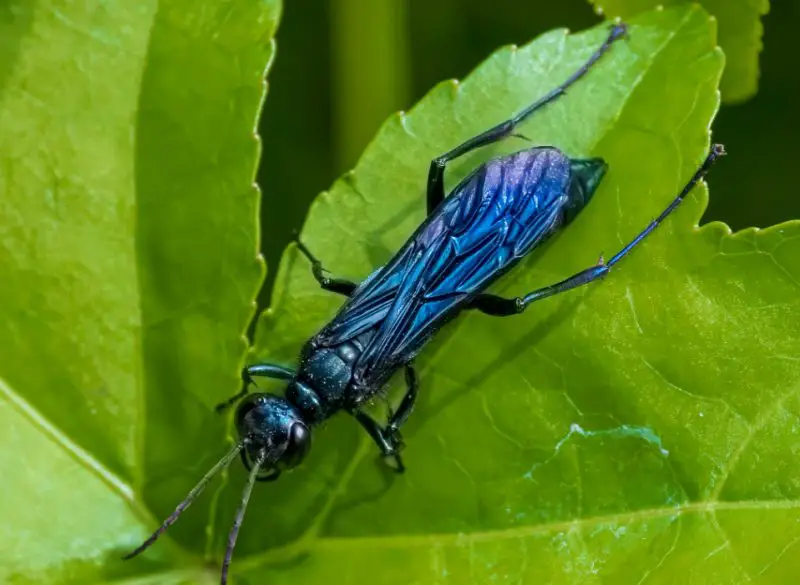
The Blue Mud Dauber is a metallic blue, slender wasp about 0.8 inches long. Its iridescent body makes it one of the more visually striking wasps found in Ohio.
Unlike other mud daubers, the blue mud dauber does not build its own nests from scratch. Instead, it reuses abandoned mud dauber nests, clearing them out and provisioning them with paralyzed spiders, especially black widows.
These wasps are solitary, calm, and non-aggressive toward humans. They are often observed near buildings and barns where suitable mud nests can be found.
In Ohio, they are especially beneficial, as they help control populations of dangerous spiders. Their presence is welcomed in both rural and suburban areas.
Thread-Waisted Wasp (Ammophila spp.)
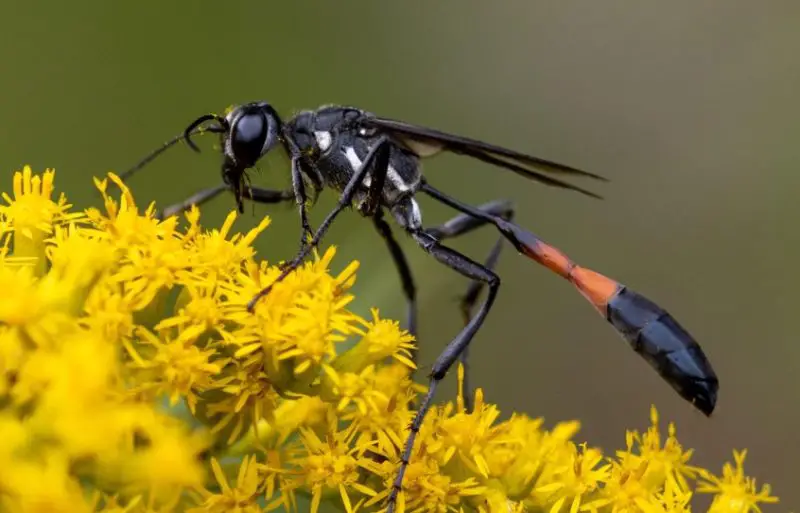
Thread-waisted wasps are easily recognized by their extremely narrow waists and elongated bodies, typically measuring 0.9 to 1.2 inches long. They are black with reddish or orange highlights on their abdomens.
These solitary hunters dig burrows in sandy soil, where they provision their nests with caterpillars or other insects. The female paralyzes prey, drags it into the burrow, and lays an egg for the larva to feed on.
Thread-waisted wasps are not aggressive and are often observed hovering low over the ground while searching for nesting sites or prey. They also visit flowers for nectar.
In Ohio, they are frequently found in open fields, meadows, and gardens during summer months, especially in areas with sandy or loose soil.
Golden Digger Wasp (Sphex ichneumoneus)
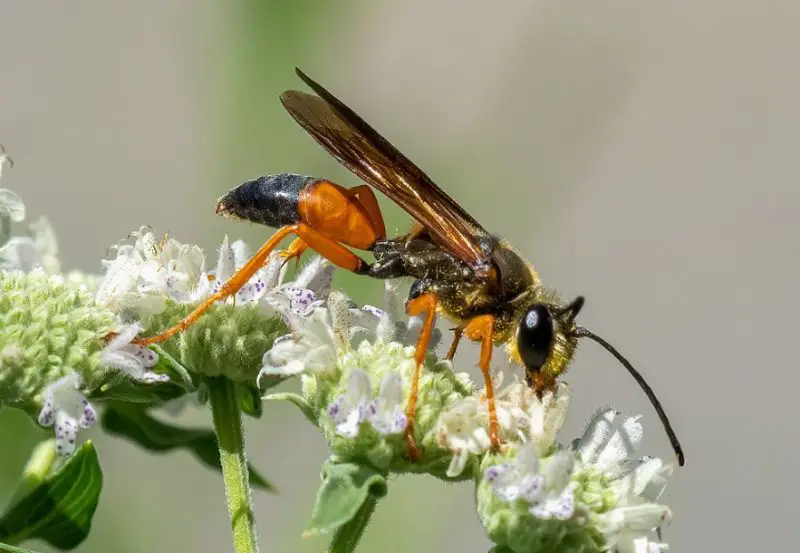
The Golden Digger Wasp is a large solitary wasp, measuring about 1.5 inches long, with a black body and bright orange or golden legs. Its long, slender abdomen and strong mandibles make it a striking predator in Ohio’s open habitats.
Females dig burrows in sandy soil and hunt katydids, crickets, or grasshoppers, which they paralyze and place in underground chambers for their larvae. Males do not hunt and are mostly observed patrolling for mates.
Golden Digger Wasps are non-aggressive toward humans and rarely sting. They are beneficial predators that help control populations of large insects that could damage gardens or crops.
In Ohio, they are most active from mid-summer to early fall, especially in sunny fields, lawns, and sandy banks.
Steel-Blue Cricket Hunter Wasp (Chlorion aerarium)
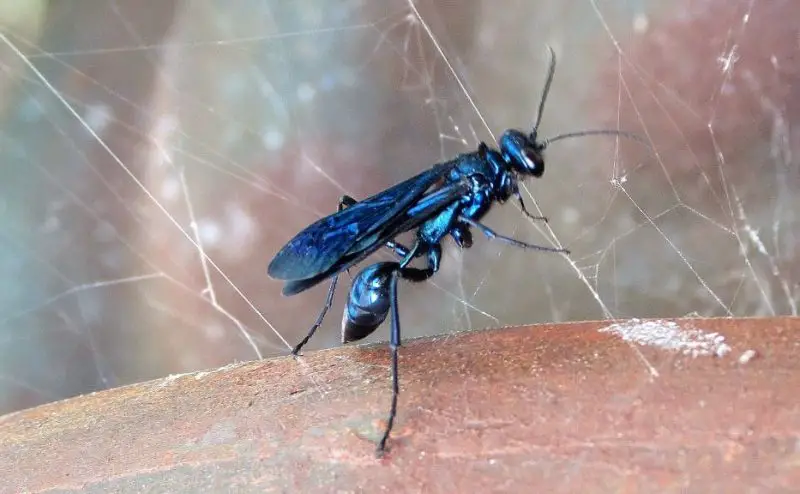
The Steel-Blue Cricket Hunter is a medium-sized solitary wasp, about 1 inch long, with a metallic blue-black body and reddish wings. Its vivid coloration makes it easy to spot on flowers or near its nesting grounds.
Females hunt crickets, paralyzing them to provision their underground burrows. Each burrow is stocked with multiple crickets for developing larvae. This predatory behavior helps naturally control pest populations.
These wasps are solitary and non-aggressive. Adults often feed on nectar from flowers, acting as incidental pollinators.
In Ohio, Steel-Blue Cricket Hunters are commonly seen during summer months in open meadows, gardens, and fields with sandy or loose soil for nesting.
Sand Wasp (Bembix spp.)
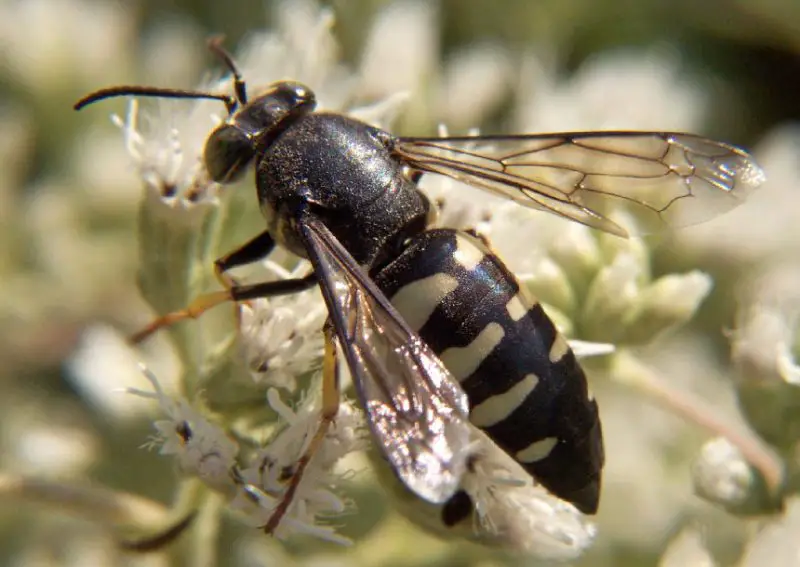
Sand Wasps are slender, solitary wasps typically 0.5 to 1 inch long, with yellow and black markings. They are excellent fliers and are often observed hovering close to the ground while searching for prey.
Females dig burrows in sandy or loose soil and hunt flies or other insects, paralyzing them to feed their larvae. Each burrow may contain several prey items carefully arranged for the developing young.
Sand Wasps are not aggressive toward humans and rarely sting. They are beneficial predators, helping to reduce fly populations in Ohio.
In Ohio, they are most active during summer, especially in sandy fields, riverbanks, and open gardens.
Beewolf Wasp (Philanthus triangulum)
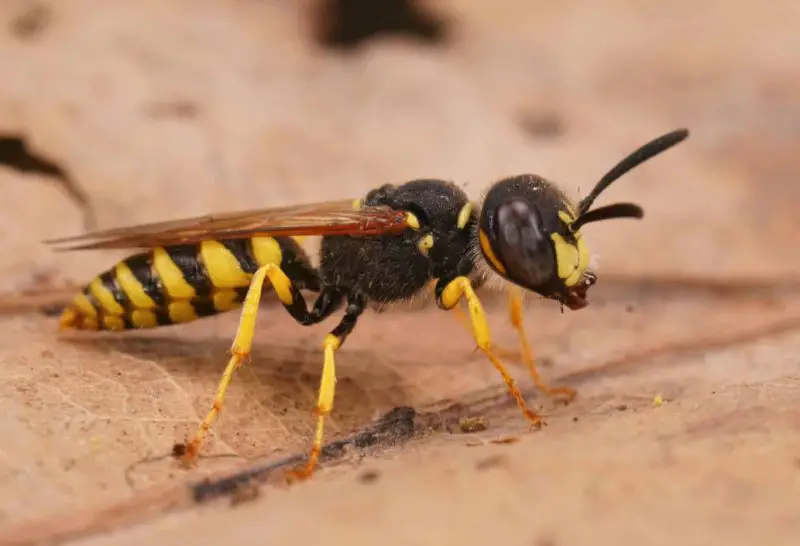
The Beewolf Wasp is a solitary wasp about 0.6 to 1 inch long, with black and yellow striped bodies resembling a small hornet. It primarily preys on honeybees and other small bees.
Females dig burrows in sandy or loose soil, capturing bees to provision each chamber for their larvae. Despite their predatory habits, beewolf wasps are not aggressive toward humans and rarely sting.
Beewolves are important ecological players, controlling wild bee populations and maintaining balance in their habitats. Adults feed on nectar and are often seen visiting flowers.
In Ohio, they are active in late spring through summer, especially in open areas, gardens, and sandy soils where bee populations are abundant.
Square-Headed Wasp (Crabronidae family)
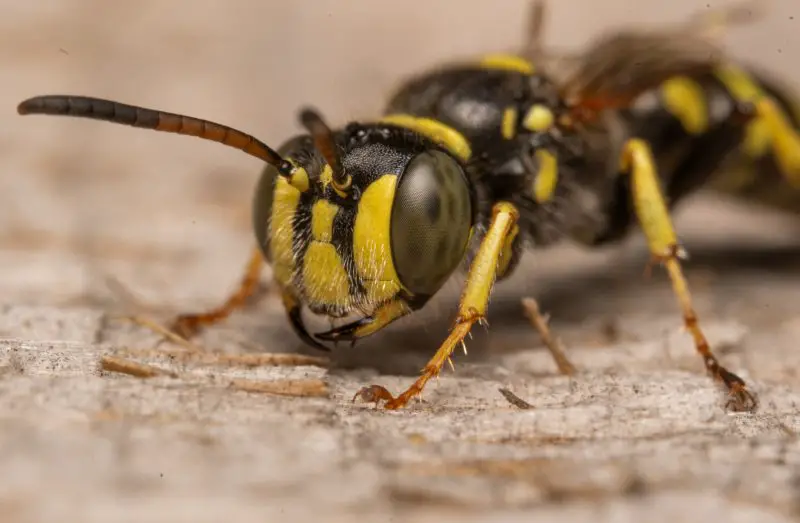
Square-Headed Wasps are medium-sized solitary wasps, about 0.5 to 0.8 inches long, with compact, square-shaped heads and black or metallic bodies. They hunt various insects to feed their larvae.
Females dig small burrows or use pre-existing cavities, provisioning each with paralyzed prey. These wasps are solitary and rarely sting, making them harmless to humans.
Adults feed on nectar and can be seen visiting flowers, contributing to pollination. They are efficient hunters that help control pest populations in gardens and fields.
In Ohio, Square-Headed Wasps are most common in meadows, woodland edges, and gardens during summer months.
Cuckoo Wasp (Chrysididae family)
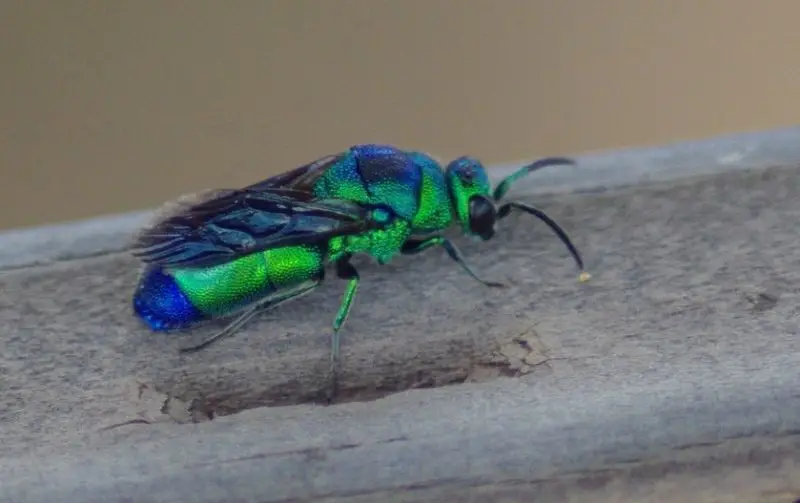
Cuckoo Wasps are small, metallic-colored wasps, often green or blue, typically measuring 0.3 to 0.6 inches long. Their iridescent bodies make them easy to recognize, and they are known for their parasitic behavior.
Unlike most wasps, cuckoo wasps do not build their own nests. Instead, they lay eggs in the nests of other solitary wasps, where their larvae consume the host’s provisions.
These wasps are solitary and non-aggressive toward humans, rarely stinging. They are fascinating examples of parasitic strategies in insects.
In Ohio, cuckoo wasps are most commonly seen in summer, often around flowers, sandy soils, or nesting sites of their host wasps.
Ichneumon Wasp (Ichneumonidae family)
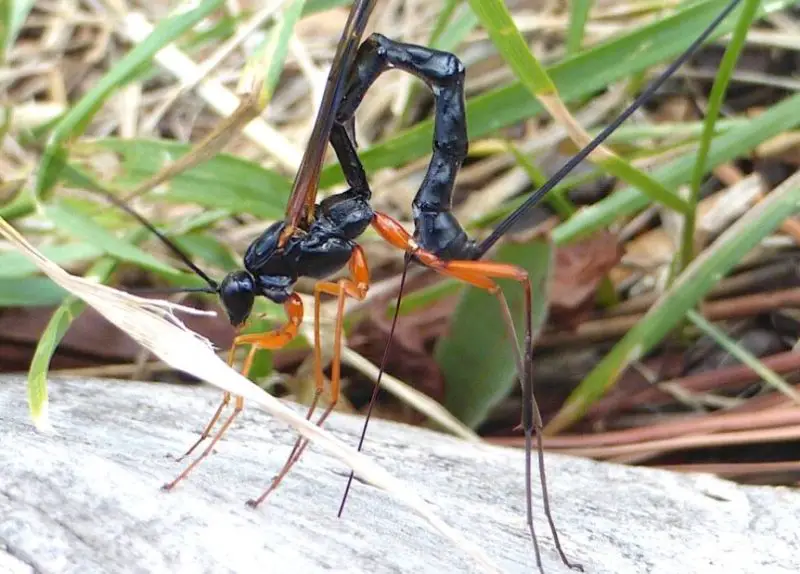
Ichneumon Wasps are a large, diverse group of parasitoid wasps, usually ranging from 0.5 to 1.5 inches long. They have slender bodies, long antennae, and ovipositors that females use to lay eggs inside or on host insects.
These wasps target caterpillars, beetle larvae, and other insects, which their larvae consume after hatching. Despite their intimidating appearance, ichneumon wasps rarely sting humans.
Adults feed on nectar and can often be seen hovering near flowers. They play a vital role in controlling pest populations in Ohio gardens and forests.
Ichneumon wasps are active from spring through late summer, frequenting open fields, gardens, and woodland edges.
Braconid Wasp (Braconidae family)
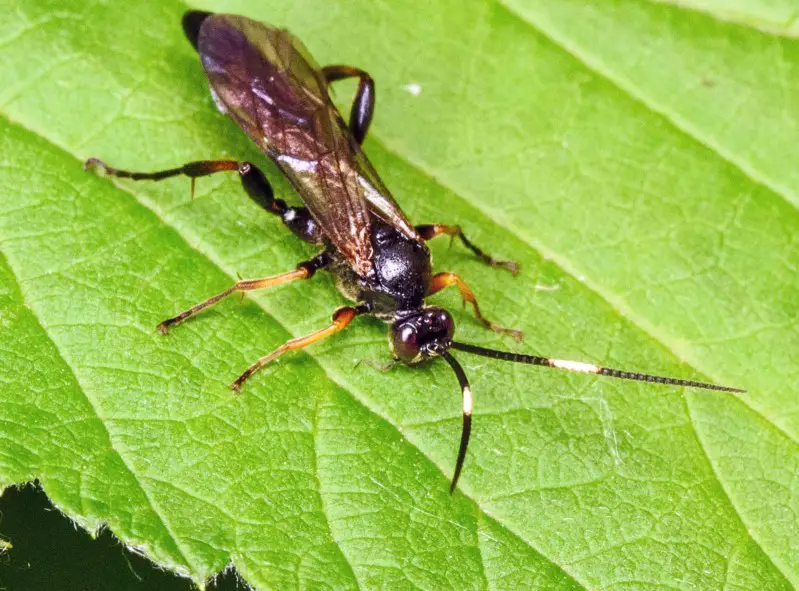
Braconid Wasps are small parasitoid wasps, usually 0.2 to 0.5 inches long, with slender bodies and varying colors from black to brown or reddish. They are highly diverse and target a wide range of insect hosts.
Females lay eggs inside caterpillars, aphids, or beetle larvae. The developing larvae consume the host from within, making braconid wasps effective biological control agents.
These wasps are harmless to humans and rarely sting. Adults feed on nectar and are often observed visiting flowers in gardens or fields.
In Ohio, braconid wasps are active throughout spring and summer, helping maintain ecological balance by controlling pest populations.
Spider Wasp (Pompilidae family)

Spider Wasps are medium to large solitary wasps, typically 0.5 to 1.5 inches long, with black or metallic bodies and long legs. They are known for hunting spiders, which they paralyze to feed their larvae.
Females dig burrows or use pre-existing cavities to place paralyzed spiders along with an egg. The larva feeds on the immobilized spider after hatching. Spider Wasps are solitary and rarely aggressive toward humans.
Adults often feed on nectar and are important pollinators. Their hunting behavior helps control spider populations in Ohio’s gardens, forests, and fields.
Spider Wasps are most active during summer months, especially in open, sunny habitats with abundant spider populations.
Eastern Velvet Ant (Dasymutilla occidentalis)

The Eastern Velvet Ant is actually a wasp, not an ant, despite its name. Females are wingless, bright red or orange, and covered in dense hair, measuring about 0.5 to 1 inch long. Males have wings and are less brightly colored.
These wasps are solitary and parasitic, laying eggs in the nests of ground-nesting bees or other wasps. The larvae consume the host’s eggs and provisions.
Female velvet ants are known for their extremely painful sting, earning them the nickname “cow killer.” However, they are not aggressive and sting only when handled.
In Ohio, they are most commonly found in sandy or open habitats during summer, foraging for suitable host nests and nectar sources.
Northern Paper Wasp (Polistes fuscatus)
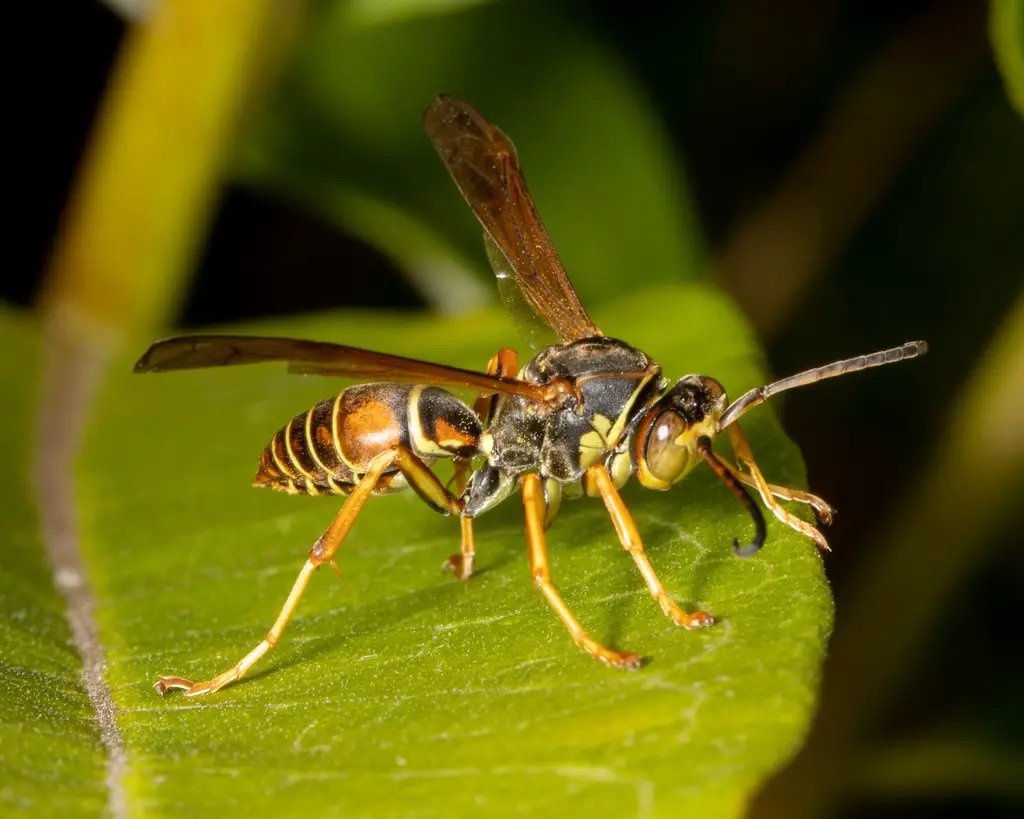
The Northern Paper Wasp is a slender, social wasp about 0.7 to 1 inch long, with a brownish body and yellow markings. Its long legs dangle noticeably during flight, making it easily identifiable.
These wasps build small, open, umbrella-shaped nests under eaves, porch ceilings, and other sheltered areas. Colonies usually contain fewer than 100 individuals.
Northern Paper Wasps are semi-aggressive, mainly defending their nests. They feed on nectar and hunt caterpillars and other soft-bodied insects, contributing to natural pest control.
In Ohio, they are active from late spring through early fall, with only fertilized queens surviving winter to start new colonies.
Guinea Paper Wasp (Polistes exclamans)
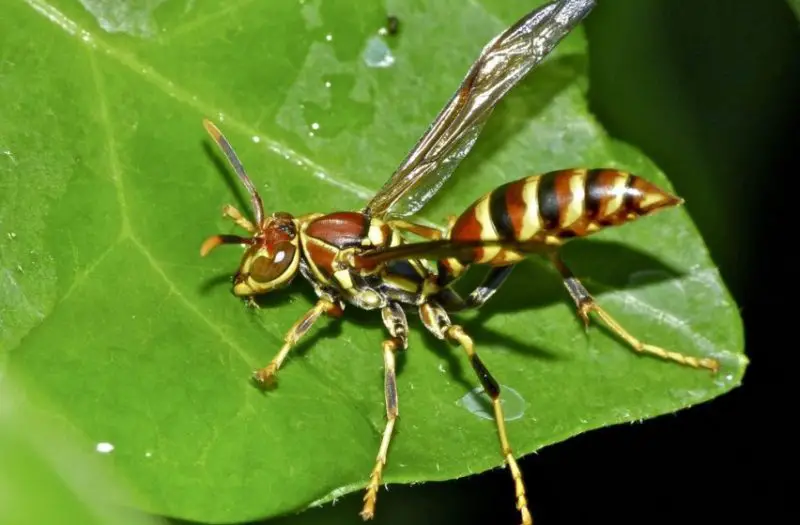
The Guinea Paper Wasp is a medium-sized social wasp, measuring about 0.6 to 0.8 inches long, with reddish-brown coloration and bright yellow markings. Its long, slender body and hanging legs make it recognizable in flight.
They construct small paper nests under sheltered areas such as eaves, porches, and tree branches. Colonies are modest in size, usually containing 20–50 individuals.
These wasps are not overly aggressive but will sting if their nests are threatened. They prey on caterpillars and other soft-bodied insects while also feeding on nectar.
In Ohio, they are active from late spring through early fall, often seen in gardens and wooded areas.
Red Paper Wasp (Polistes carolina)
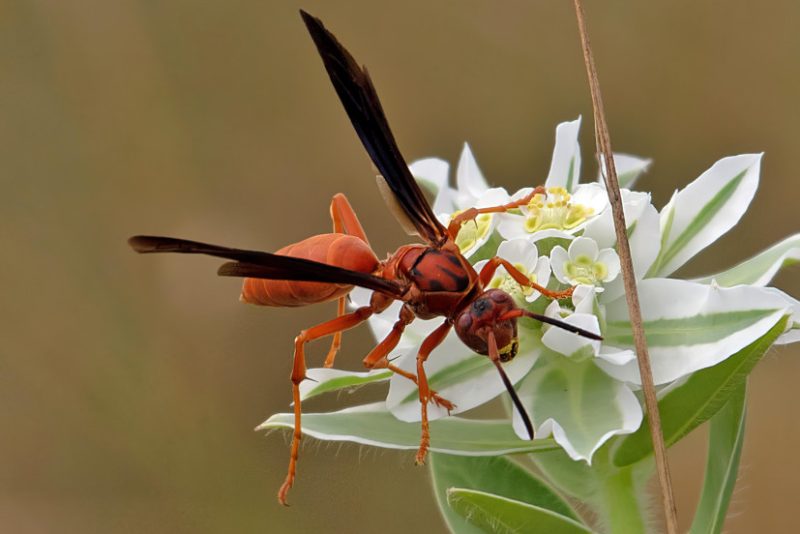
The Red Paper Wasp is a larger species, about 0.8 to 1 inch long, with reddish-brown bodies and yellow markings on the abdomen. Their long legs and slender bodies make them agile fliers.
They build umbrella-shaped paper nests in sheltered locations such as eaves, tree branches, and shrubs. Colonies are relatively small but effective at controlling garden pests.
Red Paper Wasps are semi-aggressive and will defend their nests if disturbed. They feed on nectar and hunt caterpillars, contributing to natural pest management.
In Ohio, they are active during late spring through early fall, often seen around gardens and wooded edges.
Brown Paper Wasp (Polistes metricus)
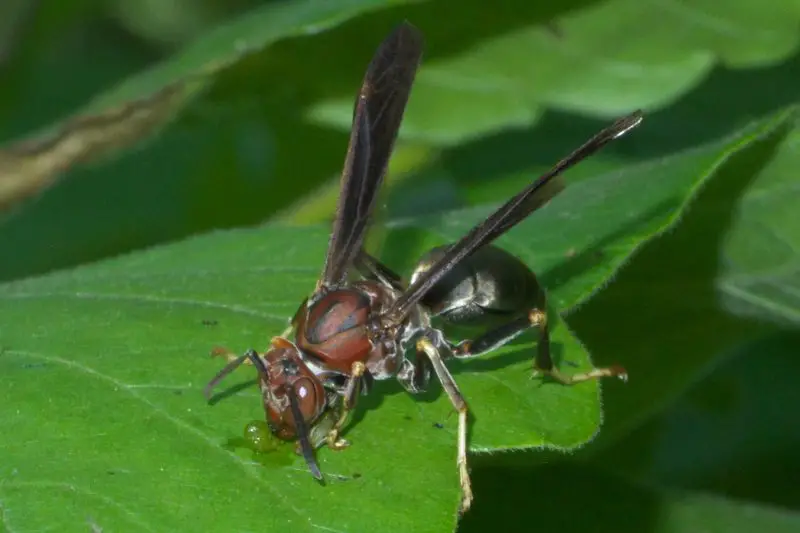
The Brown Paper Wasp is a social wasp about 0.7 to 0.9 inches long, with dark brown bodies and subtle yellow markings. Its long legs and slender shape make it distinctive in flight.
They build open, small paper nests under eaves, in shrubs, or on porch ceilings. Colonies typically remain under 100 individuals.
Brown Paper Wasps are not highly aggressive but will sting to defend their nests. They prey on caterpillars and other soft-bodied insects while also visiting flowers for nectar.
In Ohio, these wasps are active from late spring to early fall, commonly found near human structures and garden areas.
Great Golden Digger Wasp (Sphex ichneumoneus)

The Great Golden Digger Wasp is a large solitary wasp, measuring about 1.5 inches long, with a black body and bright orange or golden legs. Its long, slender abdomen is characteristic.
Females dig burrows in sandy or loose soil, hunting crickets, katydids, or grasshoppers to paralyze and provide for their larvae. Males do not hunt and are mainly seen patrolling for mates.
These wasps are non-aggressive and rarely sting, playing an important role in controlling large insect populations.
In Ohio, they are active from mid-summer to early fall, often in fields, lawns, and open habitats.
Grass-Carrying Wasp (Isodontia mexicana)
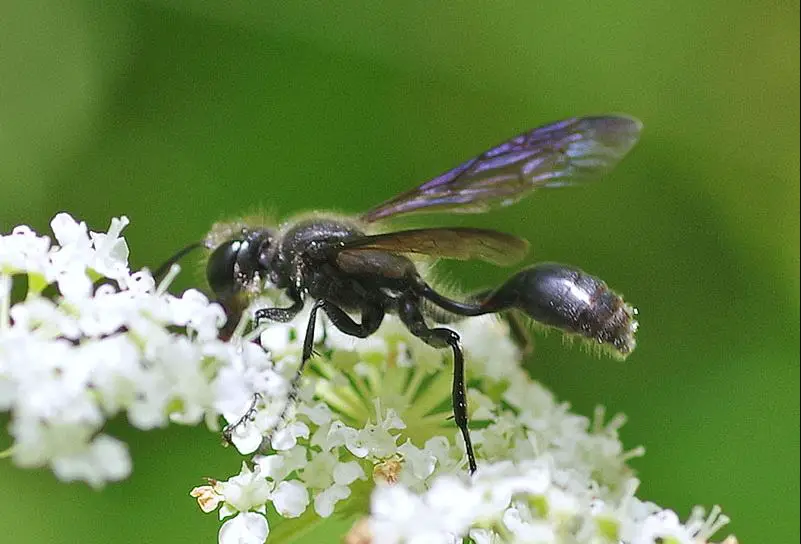
The Grass-Carrying Wasp is a solitary wasp about 0.8 to 1 inch long, with a black body and reddish markings on the abdomen. It is a strong flier with long wings and a slender body.
Females build nests in hollow stems or pre-existing cavities, filling them with grass and paralyzed katydids or crickets to feed their larvae.
They are calm and rarely sting humans. In Ohio, they are most active during summer in gardens, meadows, and open fields.
Katydid Wasp (Sphex nudus)
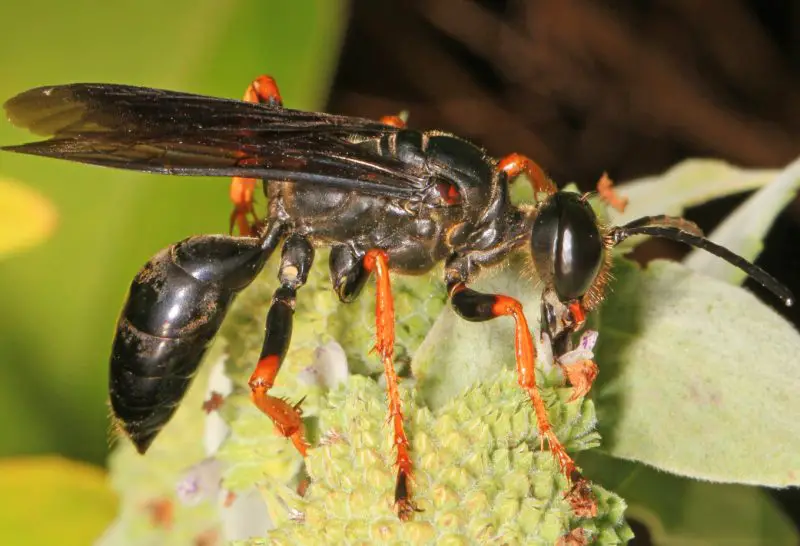
The Katydid Wasp is a solitary hunter, measuring around 1 inch long, with a black or dark brown body and orange markings. Its long legs and strong mandibles make it a proficient predator of katydids.
Females dig burrows in sandy or loose soil and provision them with paralyzed katydids for their larvae. They are non-aggressive and rarely sting humans.
Adults feed on nectar and are commonly seen hovering near flowers in Ohio during summer months, especially in open fields and gardens.
Horse Guard Wasp (Stictia carolina)
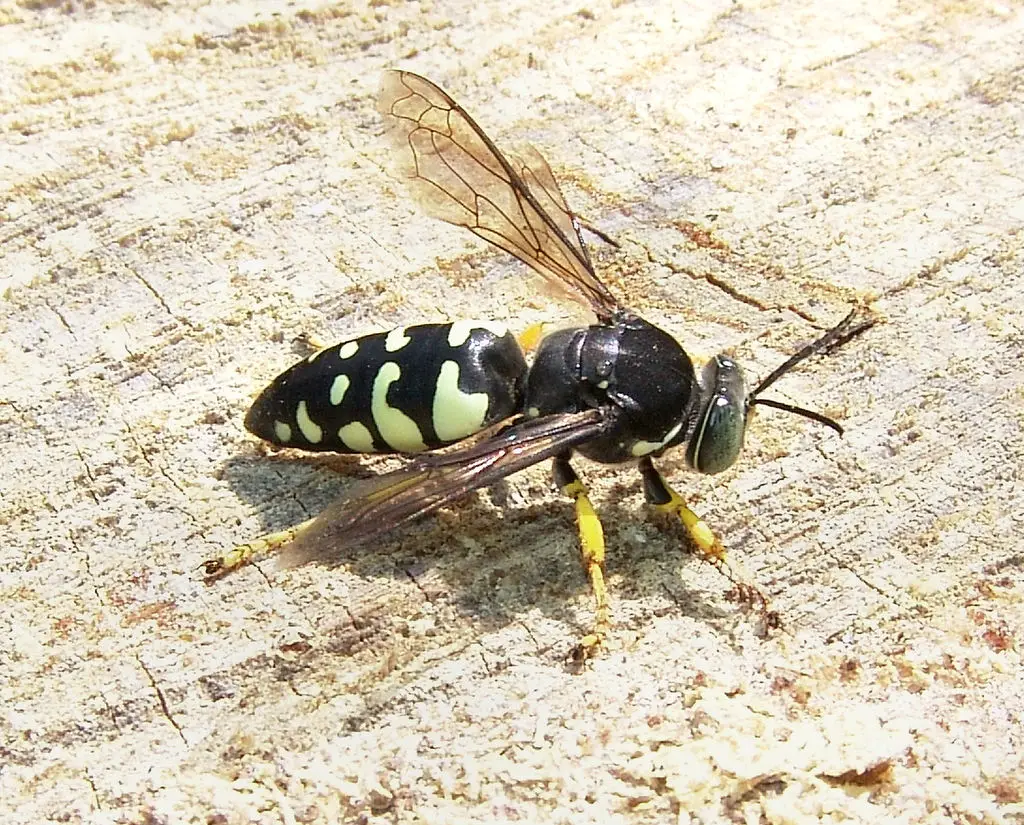
The Horse Guard Wasp is a medium-sized solitary wasp, about 1 inch long, with a yellow and black patterned body. Its robust build and agile flight make it effective at hunting prey.
Females hunt horse-flies and other large insects to provision underground burrows for their larvae. They do not form colonies and are generally non-aggressive.
In Ohio, Horse Guard Wasps are active in summer, especially in pastures, meadows, and open sunny areas where horse-flies are abundant.
Frequently Asked Questions About Wasps in Ohio
How can I tell the difference between wasps and bees in Ohio?
Wasps generally have slender, smooth bodies with narrow waists and long legs, while bees are more robust, hairy, and covered in pollen. Wasps are often more aggressive and feed on other insects in addition to nectar, whereas bees mainly collect pollen and nectar.
Are all wasps in Ohio aggressive or dangerous to humans?
No. Only social wasps like yellowjackets, hornets, and bald-faced hornets are aggressive when defending their nests. Most solitary wasps, such as mud daubers, cicada killers, and mason wasps, are non-aggressive and rarely sting unless handled.
What is the best way to avoid getting stung by wasps in Ohio?
Avoid disturbing nests, stay calm around flying wasps, and cover food and drinks when outdoors. Wear light-colored clothing and avoid strong perfumes, as bright colors and scents can attract wasps.
When are wasps most active in Ohio?
Wasps are most active during late spring through early fall. Social wasps build colonies that peak in late summer, while solitary wasps are usually seen hunting or foraging during summer months.
Do wasps provide any benefits in Ohio?
Yes. Wasps are natural pest controllers, preying on caterpillars, crickets, flies, and other insects. Many wasps also act as pollinators while feeding on nectar, contributing to the ecosystem and benefiting gardens and farms.
How can I identify the different types of wasps in Ohio?
Identification depends on size, body shape, coloration, and nesting habits. Social wasps like yellowjackets and hornets live in colonies with paper nests, while solitary wasps like mud daubers and cicada killers use soil, mud, or hollow stems for their nests.
Are Eastern Velvet Ants actually ants or wasps?
Eastern Velvet Ants are actually wasps. Females are wingless and brightly colored, while males have wings. They are solitary and parasitic, laying eggs in nests of ground-nesting bees or other wasps.


